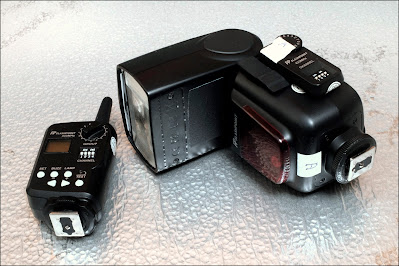After my recent experience at Bethlehem A.D. 2021, I started to re-think what I carry in my supplementary lighting bag. In the past, the speedlights, modifiers, and mounting bits and pieces were thrown into a partition-less Tenba bag, making it necessary to rummage through a jumble of lighting stuff, searching for the bits needed to assemble a proper lighting solution. Working at night with only a miner's lamp on my head doesn't make the task an easy one.
 |
| Buy your Domke bag here. |
This catalog photo shows how I packed my equipment. With the partitions installed, you can see how easy it was to extract anything I needed.I would use the external pockets to hold two or more speedlights, while I kept the lenses and bodies in the padded interior. I still think the Domke is a great bag, but the weight of a full-blown system made me re-think my choosing Nikon DSLRs as my first-line, go to cameras. When I shifted to Fuji, much of the weight had been eliminated and my main carry bag got much smaller. But as my lighting solutions became more sophisticated, there were other carry issues to be addressed.
Initially, I relied heavily on the Nikon OEM CLS system, and employed the expensive (for the time) SB-800s and SB-900s for my primary flashes. When I started using Fujis, I tried to stay with the Fuji OEM speedlights, but found them overpriced and underpowered, and I never felt that their TTL exposure metering was consistent enough for my purposes. Eventually I used my Nikon speedlights manually and relied on their native SU-4 (optical trigger) mode when multiple speedlights were needed.
Radio Triggered Flashes: As my conversion to Fuji is pretty much complete, I started to think about how much of my old equipment could be re-purposed to a mirrorless lifestyle. The aforementioned Tenba bag has been my constant, though disorganized, companion for several years, having served as my primary Nikon camera bag in my pre-Domke years. In my re-imagination of the ultimate bag, organization of my speedlights was first in mind. I took an insert from a Think Tank Change Up camera pack, added some additional padded partitions, and voilà, my speedlights were now neatly arranged and easily accessible. And should I return to the Nikon world, the partitions will accommodate SB-800 and SB-900 speedlights without any additional adjustment. |
| "Flash A" with settings taped in place. |
 |
| Buy yours here. |
For the moment, this little box currently holds all of the loose "heavies" that I brought with me on my last assignment, and the contents could be easily changed if the situation warrants. Spare camera batteries are usually kept in the camera bag and not the flash bag, but misfortunes arrive when it's least expected. It's comforting to know that I have spares in two different places.

